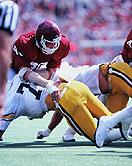
FRIDAY, Aug. 9 (HealthDay News) — The dispute over whether playing football raises the risk of developing a degenerative brain disorder has surfaced again with reports on the death of a former Michigan college quarterback and findings from a study involving 500 former NFL players.
A just-released autopsy revealed that Cullen Finnerty, 30, who played for Grand Valley State, died of pneumonia, complicated by the brain disorder known as chronic traumatic encephalopathy (CTE), Michigan’s Lake County Sheriff’s Office said Thursday, according to a report in USA Today. Finnerty’s body was found May 28 in Lake County two days after he went missing from a solo fishing trip, according to news reports.
The progressive condition — characterized by impulsivity, depression and erratic behavior — has been reported in athletes who were subjected to repetitive trauma of the brain, including concussions.
But a new study involving interviews with former National Football League players challenges the widely held belief that retired NFL players are at risk for CTE.
Researchers from Loyola University Medical Center in Maywood, Ill., say they found no evidence to support the theory after interviewing more than 500 retired football players over age 50 who played in the NFL for an average of 7.5 years. Their research was published online July 31 in the Journal of the International Neuropsychological Society.
“We still do not know if NFL players have an increased risk of late-life neurodegenerative disorders,” said researcher Christopher Randolph. “If there is a risk, it probably is not a great risk. And there is essentially no evidence to support the existence of any unique clinical disorder such as CTE.”
Based on their interviews, the researchers said 35 percent of the pro-ball players showed signs of mental decline (cognitive impairment). The researchers then compared 41 players with probable mild mental impairment to a group of non-athletes with similar impairment and a group of healthy people.
The mentally impaired retired NFL players had obvious signs of mental decline when compared to the healthy people, the researchers said, but the patterns of their mental impairments were virtually identical to those in non-athletes with mild cognitive impairment.
“The retired NFL players basically look like regular patients who have mild cognitive impairment and have never played football,” Randolph said in a Loyola news release.
The rate of possible mental decline in the NFL retirees was higher than the researchers expected, Randolph added. But, he said, “it is important to note that we did not have any controls in that part of the study, so we still do not know whether or not NFL players actually have a higher risk of later-life cognitive impairments than men in the general population.”
Experts point out that the only way to diagnose CTE is by autopsy.
In Finnerty’s case, a statement from Grand Valley College confirmed that he had suffered one concussion as a college player, but the brain injury was determined to be mild. “He was removed from the game shortly after halftime and did not play again that day. He was thoroughly checked by doctors and was later cleared for play in a subsequent game,” the college said, according to The Grand Rapids Press.
After leaving Grand Valley, Finnerty joined the Ravens and then the Broncos but never played in any NFL games.
Finnerty, at the time of his death, had been taking painkillers prescribed for a back injury, according to news reports, and the medical examiner’s report said these also probably played a part in his death, USA Today reported.
It’s believed Finnerty became incapacitated, and then inhaled vomit, which resulted in pneumonia. The medical examiner said he probably became disoriented, anxious and paranoid from being on his own in the woods while waiting for his family to pick him up, according to USA Today.
The possible link between football-related head injuries and CTE arose again last year after NFL star linebacker Junior Seau killed himself. Experts suspect — but can’t prove — that CTE may have led Seau to suicide.
After his death, the U.S. National Institutes of Health examined his brain tissue and concluded that the cellular changes that were seen were similar to those found in autopsies of people “with exposure to repetitive head injuries.”
CTE was first noticed in boxers who suffered blows to the head over many years. More recently, football players have become the focus of study.
In recent years, concerns about CTE have led high school and college programs to restrict hits to the head, and the NFL prohibits helmet-to-helmet hits.
About 4,000 former NFL players filed a class-action lawsuit last year claiming the league failed to protect players from traumatic brain injuries or warn them about the dangers of concussions. The NFL has said that it never intentionally hid the dangers of concussion from players, and that it is now doing what it can to protect players against concussions. The league has given a $30 million research grant to the U.S. National Institutes of Health for that purpose.
Last December, Boston University School of Medicine researchers reported in the journal Brain that people with CTE experience four specific phases, beginning with memory disruption and thinking problems and ending with aggression.
The Boston researchers said the condition had been diagnosed in 34 former professional players and nine former college football players.
More information
The Boston University Center for the Study of Traumatic Encephalopathy has more about chronic traumatic encephalopathy.
Copyright © 2026 HealthDay. All rights reserved.

